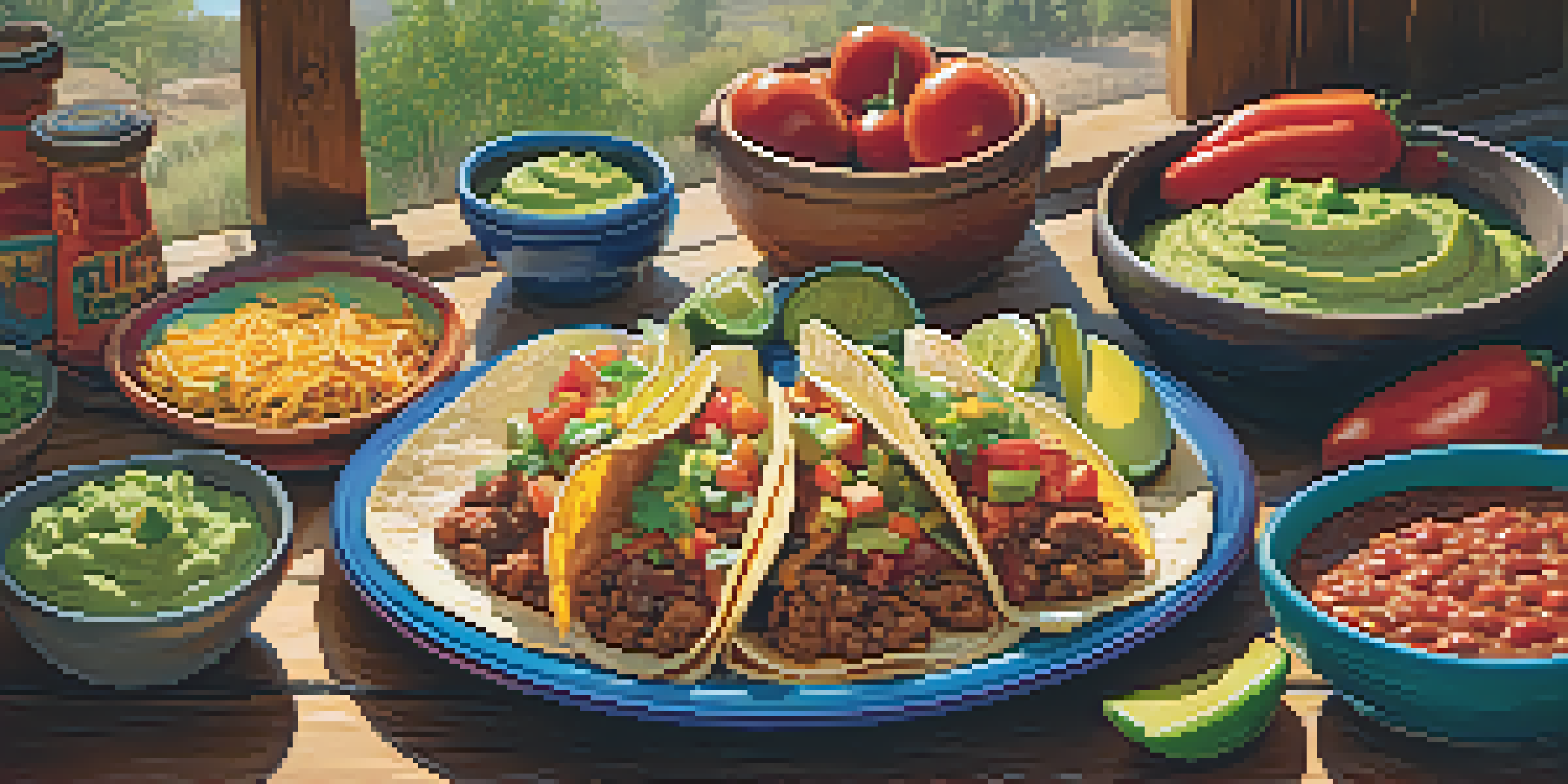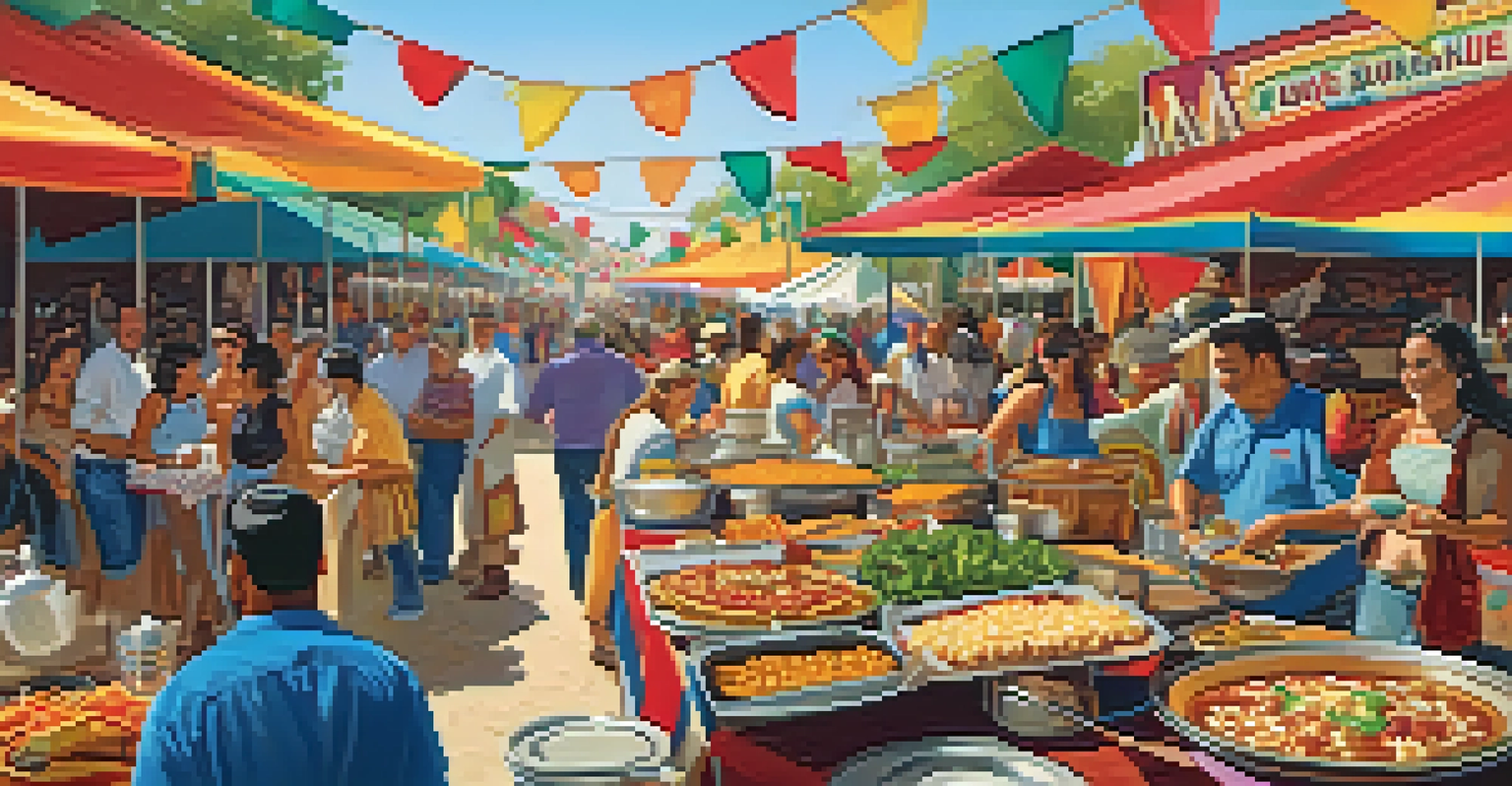Tex-Mex Cuisine: Fusing Mexican and American Flavors

What is Tex-Mex Cuisine? An Overview of Its Origins
Tex-Mex cuisine is a delightful fusion of Mexican and American flavors, particularly from Texas. This culinary style emerged in the late 19th century as Mexican immigrants settled in Texas and adapted traditional recipes to include readily available American ingredients. Think of it as a cultural conversation on a plate, where both culinary traditions share their stories through food.
Food is our common ground, a universal experience.
Dishes like chili con carne and fajitas exemplify the Tex-Mex spirit, showcasing hearty ingredients and bold flavors. Unlike traditional Mexican cuisine, which often emphasizes fresh herbs and subtle spices, Tex-Mex tends to lean towards spicier, richer flavors with a focus on meat and cheese. It’s a vibrant tapestry woven from the threads of two cultures, making it both unique and widely popular.
Today, Tex-Mex is not just a regional dish; it's a beloved staple across the United States. You’ll find it in restaurants, food trucks, and home kitchens, bringing people together for shared meals that celebrate this delicious blend. The next time you enjoy a plate of nachos or a cheesy enchilada, remember you’re savoring a piece of culinary history!
Key Ingredients That Define Tex-Mex Dishes
When it comes to Tex-Mex cuisine, certain ingredients stand out as the backbone of many beloved dishes. Cheese, particularly yellow cheese like Cheddar, is a hallmark, often melted generously over nachos or enchiladas. Beans, whether refried or black, also play a significant role, adding both flavor and texture to meals.

Another essential component is the use of tortillas, which can be flour or corn, serving as the base for tacos, burritos, and quesadillas. Tex-Mex recipes often favor flour tortillas due to their softness and versatility, making them perfect for wrapping up hearty fillings. And let’s not forget the vibrant use of spices such as cumin, chili powder, and paprika, which elevate the dishes to new flavor heights.
Tex-Mex: A Culinary Fusion
Tex-Mex cuisine blends Mexican and American flavors, creating a unique culinary style that emerged from the cultural exchange between Mexican immigrants and Texan ingredients.
Fresh ingredients like onions, tomatoes, and jalapeños are frequently incorporated, bringing a fresh crunch to the richness of the cheese and meats. This combination of ingredients creates a balance that is both satisfying and exciting to the palate, embodying the spirit of Tex-Mex cuisine in every bite.
Popular Tex-Mex Dishes You Must Try
One cannot explore Tex-Mex cuisine without mentioning some of its iconic dishes. Tacos, for instance, are a celebrated favorite, often filled with seasoned ground beef, fresh lettuce, diced tomatoes, and, of course, plenty of cheese. There’s something undeniably satisfying about holding a taco in your hands, ready to take a bite of that flavorful explosion.
Cooking is like love. It should be entered into with abandon or not at all.
Another must-try dish is the enchilada, which features corn tortillas rolled around a filling, typically smothered in a savory red or green sauce. The beauty of enchiladas lies in their adaptability; you can fill them with anything from shredded chicken to cheese or even vegetables. It’s a testament to how Tex-Mex cuisine embraces creativity and personal taste.
And let’s not overlook the ever-popular fajitas, which are served sizzling hot, often bringing a delightful aroma to the table. Typically made with grilled meat, bell peppers, and onions, fajitas are served with warm tortillas, allowing diners to create their own wraps. Each of these dishes tells a story of flavor and culture, inviting everyone to indulge in the Tex-Mex experience.
The Role of Sides in Tex-Mex Meals
In Tex-Mex cuisine, sides are not just an afterthought; they play a crucial role in rounding out a meal. Classic sides like Spanish rice and refried beans frequently accompany main dishes, providing a comforting balance. Spanish rice, cooked with tomatoes and spices, adds a delightful flavor contrast to the richness of the main course.
Guacamole is another beloved side that often steals the spotlight. This creamy avocado dip, seasoned with lime, garlic, and cilantro, is the perfect accompaniment to crispy tortilla chips or as a topping for tacos. Its freshness cuts through the heavier flavors of Tex-Mex dishes, making it a favorite for many.
Key Ingredients of Tex-Mex
Cheese, tortillas, beans, and vibrant spices are essential components that define Tex-Mex dishes, offering a satisfying balance of flavors and textures.
Additionally, salsas come in various styles, from mild to spicy, and can be made fresh or cooked. Whether you prefer a chunky pico de gallo or a smooth roasted salsa, they provide a burst of flavor that enhances every bite. Together, these sides create a well-rounded dining experience that celebrates the vibrant flavors of Tex-Mex cuisine.
Tex-Mex and Its Influence on American Culture
Tex-Mex cuisine has profoundly influenced American food culture, becoming a beloved staple across the country. Its casual dining style and bold flavors have made it a go-to choice for family gatherings, parties, and celebrations. Many people associate Tex-Mex with comfort food, fostering a sense of community and connection through shared meals.
The rise of Tex-Mex restaurants in urban areas has introduced many to this delightful fusion. These establishments often create a lively atmosphere, complete with colorful decor and music, making dining out a fun experience. As a result, Tex-Mex has not only become a popular cuisine but also a part of American identity.
Furthermore, the influence of Tex-Mex can be seen in other culinary areas, such as the emergence of fusion dishes that blend Tex-Mex with other cuisines. This adaptability showcases the creativity and innovation that Tex-Mex inspires, ensuring its place in the ever-evolving landscape of food culture in America.
The Health Aspect of Tex-Mex Cuisine
While Tex-Mex cuisine is often associated with indulgent dishes, there are plenty of healthy options available. Many traditional ingredients, such as beans, vegetables, and lean meats, can contribute to a balanced diet. For instance, black beans are a fantastic source of protein and fiber, making them a nutritious addition to any meal.
Moreover, fresh ingredients like tomatoes, onions, and avocados are commonly used, offering a wealth of vitamins and healthy fats. Dishes can easily be modified to include more vegetables or lean proteins, allowing for a healthier take on classic Tex-Mex favorites. This flexibility means that you can enjoy the flavors without sacrificing nutrition.
Tex-Mex's Cultural Impact
Tex-Mex has significantly influenced American food culture, becoming a staple in casual dining and fostering community through shared meals and celebrations.
It’s also worth noting that portion control can play a significant role in enjoying Tex-Mex cuisine healthily. By savoring smaller portions and opting for lighter sides, you can indulge in the rich flavors while maintaining a balanced approach to eating. Tex-Mex cuisine can indeed be both delicious and nutritious!
Celebrating Tex-Mex: Events and Festivals
Tex-Mex cuisine isn’t just about the food; it’s also about the culture that surrounds it. Various events and festivals celebrate this vibrant culinary tradition, bringing people together to enjoy delicious dishes and lively entertainment. For instance, many cities host Tex-Mex food festivals, featuring local chefs and restaurants showcasing their best recipes.
These festivals often include cooking demonstrations, where attendees can learn about the techniques behind their favorite dishes. It’s an exciting opportunity to delve deeper into the flavors of Tex-Mex cuisine and discover new recipes to try at home. Plus, there’s usually live music and dancing, creating a festive atmosphere that celebrates the cultural roots of Tex-Mex.

Additionally, national holidays and events, such as Cinco de Mayo, often see celebrations that feature Tex-Mex food as a central theme. Families and friends gather for backyard barbecues or potlucks, sharing plates of tacos, nachos, and more. It’s a beautiful reminder of how food can bring people together, fostering community and joy through the shared experience of Tex-Mex cuisine.